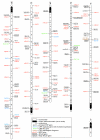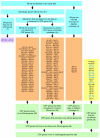The ribosomal protein genes and Minute loci of Drosophila melanogaster
- PMID: 17927810
- PMCID: PMC2246290
- DOI: 10.1186/gb-2007-8-10-r216
The ribosomal protein genes and Minute loci of Drosophila melanogaster
Abstract
Background: Mutations in genes encoding ribosomal proteins (RPs) have been shown to cause an array of cellular and developmental defects in a variety of organisms. In Drosophila melanogaster, disruption of RP genes can result in the 'Minute' syndrome of dominant, haploinsufficient phenotypes, which include prolonged development, short and thin bristles, and poor fertility and viability. While more than 50 Minute loci have been defined genetically, only 15 have so far been characterized molecularly and shown to correspond to RP genes.
Results: We combined bioinformatic and genetic approaches to conduct a systematic analysis of the relationship between RP genes and Minute loci. First, we identified 88 genes encoding 79 different cytoplasmic RPs (CRPs) and 75 genes encoding distinct mitochondrial RPs (MRPs). Interestingly, nine CRP genes are present as duplicates and, while all appear to be functional, one member of each gene pair has relatively limited expression. Next, we defined 65 discrete Minute loci by genetic criteria. Of these, 64 correspond to, or very likely correspond to, CRP genes; the single non-CRP-encoding Minute gene encodes a translation initiation factor subunit. Significantly, MRP genes and more than 20 CRP genes do not correspond to Minute loci.
Conclusion: This work answers a longstanding question about the molecular nature of Minute loci and suggests that Minute phenotypes arise from suboptimal protein synthesis resulting from reduced levels of cytoribosomes. Furthermore, by identifying the majority of haplolethal and haplosterile loci at the molecular level, our data will directly benefit efforts to attain complete deletion coverage of the D. melanogaster genome.
Figures




Similar articles
-
Cardiomyopathy is associated with ribosomal protein gene haplo-insufficiency in Drosophila melanogaster.Genetics. 2011 Nov;189(3):861-70. doi: 10.1534/genetics.111.131482. Epub 2011 Sep 2. Genetics. 2011. PMID: 21890737 Free PMC article.
-
A Drosophila Minute gene encodes a ribosomal protein.Nature. 1985 Oct 10-16;317(6037):555-8. doi: 10.1038/317555a0. Nature. 1985. PMID: 4047173
-
Genetic analysis of RpL38 and RpL5, two minute genes located in the centric heterochromatin of chromosome 2 of Drosophila melanogaster.Genetics. 2005 Feb;169(2):683-95. doi: 10.1534/genetics.104.034124. Epub 2004 Nov 1. Genetics. 2005. PMID: 15520262 Free PMC article.
-
The minute genes in Drosophila and their molecular functions.Adv Genet. 1998;38:69-134. doi: 10.1016/s0065-2660(08)60142-x. Adv Genet. 1998. PMID: 9677706 Review. No abstract available.
-
Ribosomal proteins: mutant phenotypes by the numbers and associated gene expression changes.Open Biol. 2020 Aug;10(8):200114. doi: 10.1098/rsob.200114. Epub 2020 Aug 19. Open Biol. 2020. PMID: 32810425 Free PMC article. Review.
Cited by
-
In vivo evidence for homeostatic regulation of ribosomal protein levels in Drosophila.Cell Struct Funct. 2024 Feb 16;49(1):11-20. doi: 10.1247/csf.23088. Epub 2024 Jan 11. Cell Struct Funct. 2024. PMID: 38199250 Free PMC article.
-
The RICE MINUTE-LIKE1 (RML1) gene, encoding a ribosomal large subunit protein L3B, regulates leaf morphology and plant architecture in rice.J Exp Bot. 2016 May;67(11):3457-69. doi: 10.1093/jxb/erw167. J Exp Bot. 2016. PMID: 27241493 Free PMC article.
-
RpL22e, but not RpL22e-like-PA, is SUMOylated and localizes to the nucleoplasm of Drosophila meiotic spermatocytes.Nucleus. 2013 May-Jun;4(3):241-58. doi: 10.4161/nucl.25261. Epub 2013 Jun 6. Nucleus. 2013. PMID: 23778934 Free PMC article.
-
In Vivo Senescence in the Sbds-Deficient Murine Pancreas: Cell-Type Specific Consequences of Translation Insufficiency.PLoS Genet. 2015 Jun 9;11(6):e1005288. doi: 10.1371/journal.pgen.1005288. eCollection 2015 Jun. PLoS Genet. 2015. PMID: 26057580 Free PMC article.
-
Identification, expression and target gene analyses of Micrornas in Spodoptera litura.PLoS One. 2012;7(5):e37730. doi: 10.1371/journal.pone.0037730. Epub 2012 May 25. PLoS One. 2012. PMID: 22662202 Free PMC article.
References
-
- Kay MA, Jacobs-Lorena M. Developmental genetics of ribosome synthesis in Drosophila. Trends Genet. 1987;3:347–351. doi: 10.1016/0168-9525(87)90295-2. - DOI
-
- Lambertsson A. The Minute genes in Drosophila and their molecular functions. Adv Genet. 1998;38:69–134. - PubMed
-
- Wool IG, Chan YL, Gluck A. Structure and evolution of mammalian ribosomal proteins. Biochem Cell Biol. 1995;73:933–947. - PubMed
Publication types
MeSH terms
Substances
Grants and funding
LinkOut - more resources
Full Text Sources
Other Literature Sources
Molecular Biology Databases
Research Materials
Miscellaneous

